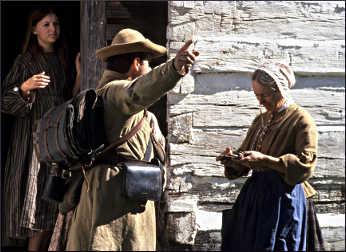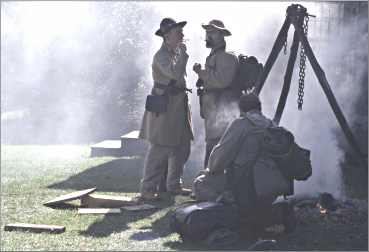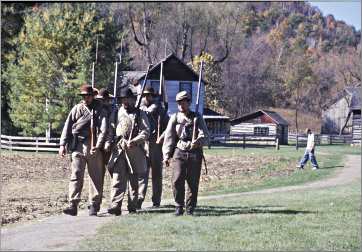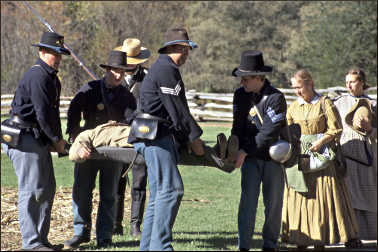Civil War, up close
In the southwest Wisconsin countryside, expert reenactors bring the misery of war home.

© Beth Gauper
It was a gorgeous fall day in southwest Wisconsin, and all we could see was heartache and misery.
"Welcome to Virginia 1862," read the sign at the gates of Norskedalen, where pioneer homesteads evoke the Civil War era.
Pushing open the door of a chinked-timber farmhouse, we encountered Nedda Blodgett, who was surprised to find strangers in her parlor but quickly welcomed us in a Southern drawl.
"Why, you must be refugees, too," she said with a nervous smile. "S'pose you're lookin' for something to eat. Ah don't have much; those boys take about ever'thing."
The "boys" were Confederate troops, who were in her back yard burning hay so advancing Union troops couldn't use it for their own horses.
"They already know we're here; they been probin' all day," one of them told us. "And the more smoke, the more people they may think we have."
Behind us, a tourist explained to her children that the soldiers were taking the family's food. Blodgett quickly corrected her.
"No, we're giving them our food," she said. "We leave all the dishonorable jobs to the Yankees."
Yankees, she said, had given her friend Becca and her friend's young daughters half an hour to leave their home, and they'd fled to Nedda's house. Now, Yankees were advancing on Nedda's house, too, and it was too much for Becca.
"I lost my house and my husband; I lost everything," she said, her voice quavering. "I'm just so fearful for my life and my children. I do apologize for my emotional state."
A soldier told her to collect her valuables and flee to the farm over the hill, so one of her daughters dashed to the stone springhouse and came back with a jar of pickled eggs. Then, we heard a boom, and the women and children ran out the door.
From a hillside, we watched as Rebels began loading, ramming, priming and firing a cannon, whose booms resounded around the little valley.

© Torsten Muller
Rebels with muskets took up posts along a split-rail fence as Union troops began streaming across a bridge, drawing gunfire as another group of federals ran along the creek, trying to catch the enemy from behind.
Soon, the federals had overrun the Rebels' cannon and driven them toward the farmhouse. The Union commander called for a ceasefire and sent troops to check the outbuildings for Confederate sympathizers.
Live theater in the countryside
The re-enactment at Norskedalen, a pioneer heritage center whose name means "Norwegian valley," is modest as battle re-enactments go. Re-enactors use only three cannons and no cavalry, because horses tear up the grounds.
Some re-enactments are real spectacles. In eastern Wisconsin, the annual battle re-enactment near the Wade House involves as many as 50 horses and 17 cannons, which are loaded with balls of aluminum foil but use real gunpowder that delivers a charge of 18,000 pounds per square inch, enough to blow the arm off a careless loader.
Hundreds of soldiers clash on 280 acres of woods and fields, along rock-walled sunken lanes that were built by Yankee pioneers and later uncovered and cleared with the help of re-enactors.
In Southern states, re-enactments are held where battles actually took place, and they're still fraught with emotion, more than a century and a half after the war.
As near as western Missouri, where counties were devastated by guerrilla warfare, re-enactors who portray Union troops leave the field past silent, stony-faced spectators.
Each re-enactment is different. Norskedalen's is more intimate, with affecting human dramas woven into the smoke of battle.
Uncomfortable authenticity
As Union troops began to carry out the dead and wounded, others had to escort weeping women away from the scene.
Confederate troops shuffled by, filthy and as ragged as scarecrows, followed by a dazed Union soldier, with real blood streaming down his face from a fall.
On the steps of a cabin serving as an infirmary, a wounded Rebel begged for liquor to relieve his pain, so a Union soldier tipped a flask to his lips. Another bellowed for "the butcher" (field surgeon), and in the yard a private was joyfully reunited with his sergeant.

© Beth Gauper
Nedda Blodgett wandered out of the house, muttering over and over, "Ah just cain't get the beet juice off the wall," until a Union soldier pulled her back. In the yard, two women laid their heads on the breast of a dying man.
We watched the scene, transfixed, and with each sob and groan, we felt a little more shell-shocked ourselves — as if we really were in Virginia during 1862.
"Some of these people are better than a professional actor, who doesn't do as much; they live it every day," said John Thiel of nearby St. Joseph. "They practice and practice. It's really convincing. It's really hard to get out of first person. It's part of it to portray what people went through."
Thiel, who was filling in for the company surgeon, said the verisimilitude sometimes can be a little much, especially at demonstrations of how surgeons operated in the field.
"We have a litter with a hole in it, and we take some chicken guts and put the meat next to the top part of the leg," he said. "We cut right through it with a bone saw and cauterize the wound with hot metal, and when that chicken fat starts to smoke and sputter, the kids, oh man, they just walk away."
In the cabin, we met Terry Sorchy of Brodhead, Wis., who sported a black mustache and a bushy goatee.
He wore a plaid tobacco bag around his neck, square-toed boots, a jean-cloth suit coat woven on a 19th-century loom and pants dyed with logwood, a tree that grows in the West Indies.
Even if a detail can't be seen, he said, re-enactors make sure it's authentic.
"If they didn't have it on them 140 years ago, we don't have it on us," he said.
As a Confederate Mess No. 3 infantryman (cook), Sorchy offered us a slab of bacon bought from a local farmer and a pickled egg, dyed pink by beet juice. It was typical fare at the time, and he was pleased when we enjoyed them.
"All we put in is salt," he said. "Most people say, 'Ewww,' and then they go to McDonald's on the way home, and they're putting more preservatives and chemicals into their body than we ever do on a weekend like this."
It's easy to be authentic at Norskedalen, where re-enactors stay in pioneer cabins built during or just after the Civil War, sleeping on real straw ticks and boiling water on cast-iron stoves.

© Beth Gauper
"Most places, they don't want you to touch anything," Thiel said. "Here, they say, 'C'mon in, use the stove.'"
"We love this place," said Pete Seielstad of Sparta, Wis. "One lady brings a cow, a horse and a chicken, and one guy brought in a goose. The site is so beautiful, and 21st-century intrusions are pretty much obliterated."
Seielstad and Thiel are members of Company B of the Second Wisconsin, which was part of the famous Iron Brigade. Known to Confederate fighters as "the terrible Black Hats," it became the most honored brigade in the eastern army, fighting at Bull Run, Antietam and Gettysburg, where it was nearly annihilated.
Every October, Company B takes over Norskedalen's Bekkum Homestead, a collection of 13 buildings from nearby Norwegian pioneer farms, and the Holte Cabin, a Civil War-era cabin the re-enactment group helped reconstruct on the center's grounds.
"It's a camp-out with 100 of your most eccentric friends," Thiel said with a smile.
Trip Tips: Norskedalen Nature & Heritage Center
Getting there: Norskedalen is half an hour east of La Crosse, three miles north of Coon Valley on County Road PI.
Civil War Immersion Weekend: It's the second Saturday of October, with skirmishes held at 11 a.m. and 2 p.m.
Other Civil War battle re-enactments: For more on the Wade House re-enactment, see Blasts from the past.
For other re-enactments around the region, see Still fighting the Civil War.